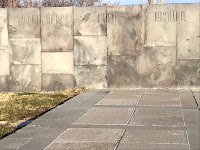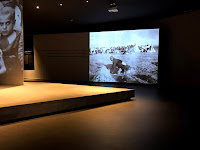 |
As part of the ethnographic approach to my dissertation, I am trying to visit many of the more commonly visited museums in terms of school field trips. One of the museums I had been putting off was to visit the Genocide Museum and Memorial. Located on a hill side, there are several ways one can approach the area near the memorial and museum entrance. I had taken the public transportation and got dropped off just across the street near the flower shop. Conveniently located, I walked into the shop and saw four red roses sitting in a vase. Vartuhi, my father's mother, was a survivor of the Genocide. She walked through the Der Zor desert with her mother and baby brother and ended up being the only one to survive from her family. Like many survivors, she ended up at an orphanage in Syria where my father was born years later. My grandmother's name "Vartuhi" refers to "vart" or rose and in memory of her family, I felt the rose was most appropriate. It was a chilly morning - around 38 degrees Fahrenheit - I guess it was cold enough for the grass to be covered in frost. As I approached the path towards the museum, a car pulled up to the parking lot with a United Nations license plate. Many folks arrived with their dogs to take them for a walk in park spaces surrounding the memorial and museum complex. The Armenia-Diaspora monument can be seen from a distance which guided me. Along my walk, I also saw folks out exercising - speed walking with their friends. It seemed like a typical morning for everyone.
I decided to first pay my respect at the eternal flame and place the roses at the memorial. Approaching the memorial, one can read names of the provinces where Armenians lived in the Ottoman Empire along this stone wall. I paused to take a photo of my families' hometowns: my mother's side was from Berecik and and my father's side from Palu. My mother says when she visited Armenia for the first time in 2006 that this site was the first time she had ever seen Berecik referenced which made her proud. She often looked for Ainteb on the map or knew Berecik was close by which is how I remember her telling us where her family came from.
 The memorial has twelve pillars representing the Ottoman provinces where Armenians once lived. In the background, I heard Armenian church hymns amplified in the speakers. An elderly lady had a broom and plastic bag where she was collecting trash. She appeared to be a member of the memorial and monument complex staff and was cleaning the memorial area. "Hurry up, let's go!" shouted a man standing at the top of the stairs. Ignoring his request, she continued to clean. Moments later she responded, "There are sunflower shells all over - I have to finish cleaning this off!" She saw me approach and smiled at me. I greeted her and smiled back. She cleared off a space near the center and said, "young lady, come place your pretty roses here - it will look nice here" as she finished clearing the wilted flower petals. I had visited this memorial far too many times that I no longer kept track. For me, its not just a memorial I visited on April 24th annually while living in Armenia - it was a place I visited many times with organized groups or at times, when I went walking with a friend. Sometimes the fire wasn't lit - but today, it was burning. The center is known as the eternal flame never to be turned off - always burning in memory of those who were massacred during the Genocide. I stood still silently taking in the somber aura with the hymns, the flame, the carnations, the birds flying above. It was cold, quiet, and calm. On the night of April 23rd, Armenians annually walk up to this site for the evening march with torches and flags - some chanting swears against Turks, others singing. The following day is a memorial day - everyone visits the memorial so streets are blocked off and crowds swarm around with their flowers. My visit this morning was between me, the cleaning lady, and my thoughts. I suspect the staff sensed I was a diasporan Armenian based on my Western Armenian dialect. I also sensed not everyone typically visits this space besides the month of April so my identity is quite obvious in this given moment.
The memorial has twelve pillars representing the Ottoman provinces where Armenians once lived. In the background, I heard Armenian church hymns amplified in the speakers. An elderly lady had a broom and plastic bag where she was collecting trash. She appeared to be a member of the memorial and monument complex staff and was cleaning the memorial area. "Hurry up, let's go!" shouted a man standing at the top of the stairs. Ignoring his request, she continued to clean. Moments later she responded, "There are sunflower shells all over - I have to finish cleaning this off!" She saw me approach and smiled at me. I greeted her and smiled back. She cleared off a space near the center and said, "young lady, come place your pretty roses here - it will look nice here" as she finished clearing the wilted flower petals. I had visited this memorial far too many times that I no longer kept track. For me, its not just a memorial I visited on April 24th annually while living in Armenia - it was a place I visited many times with organized groups or at times, when I went walking with a friend. Sometimes the fire wasn't lit - but today, it was burning. The center is known as the eternal flame never to be turned off - always burning in memory of those who were massacred during the Genocide. I stood still silently taking in the somber aura with the hymns, the flame, the carnations, the birds flying above. It was cold, quiet, and calm. On the night of April 23rd, Armenians annually walk up to this site for the evening march with torches and flags - some chanting swears against Turks, others singing. The following day is a memorial day - everyone visits the memorial so streets are blocked off and crowds swarm around with their flowers. My visit this morning was between me, the cleaning lady, and my thoughts. I suspect the staff sensed I was a diasporan Armenian based on my Western Armenian dialect. I also sensed not everyone typically visits this space besides the month of April so my identity is quite obvious in this given moment.  Gathered near the museum entrance, I was surprised to see many tourists also visiting the museum - tourists, in December, at the Genocide museum I thought to myself. Perhaps this is because of the recent passing of the US Senate Resolution recognizing the Armenian Genocide. I thought to myself this might be a reason why more folks may be attracted to this site. Moments after I entered the exhibit, three men dressed in suites entered with a museum curator and spoke English with an American accent. The curator explained to the museum staff that she would be escorting their American guests and giving them a tour. While the staff spoke to each other, these men were looking around and were in awe of the map of the Ottoman Empire on the wall. They asked several questions and before I could look up, were out of sight. It had been a while since I had visited the exhibit which allowed me to appreciate it and treat this as a new space and memory.
Gathered near the museum entrance, I was surprised to see many tourists also visiting the museum - tourists, in December, at the Genocide museum I thought to myself. Perhaps this is because of the recent passing of the US Senate Resolution recognizing the Armenian Genocide. I thought to myself this might be a reason why more folks may be attracted to this site. Moments after I entered the exhibit, three men dressed in suites entered with a museum curator and spoke English with an American accent. The curator explained to the museum staff that she would be escorting their American guests and giving them a tour. While the staff spoke to each other, these men were looking around and were in awe of the map of the Ottoman Empire on the wall. They asked several questions and before I could look up, were out of sight. It had been a while since I had visited the exhibit which allowed me to appreciate it and treat this as a new space and memory.As I continued to walk further through the exhibit, the history was presented in chronological order and progressed from early Ottoman times, through the fedayee movement, and eventually sharing stories of survival. While I was familiar with the history, I read the texts as if I had read about the Genocide for the first time. The most challenging part of this visit for me was reading the details about how people were killed: children's bodies tortured, "shortly after this photograph was taken, they were burnt alive", or after they fought in WWI for the Ottoman army, Armenians were all killed off.
The Fedayee Oath:
"I swear with my honor and nationality to put all my strengths and if need be my blood to serve the just cause of liberation of Armenia against tyranny, therefore Armenian mountains will be my pillow and my innermost desire will be to die for the sake of homeland. I'm glad and willing to bear the kiss of a sizzling bullet."

As I walked through the museum, I tried to imagine: what do school children think when they visit this museum and see this exhibit? The history was from over a 100 years ago and for most of these kids, if a family member did survive the Genocide, it would be their great, great grandparents at this point in time. Some of the images and descriptions on the walls felt like deja vu where I had just seen them in recent headlines with the attack on the Kurdish community in northern Syria.
Upon exiting the exhibit one reads on the wall Adolf Hitler's infamous quote: "Who, after all, speaks today of the annihilation of the Armenians?"









No comments:
Post a Comment